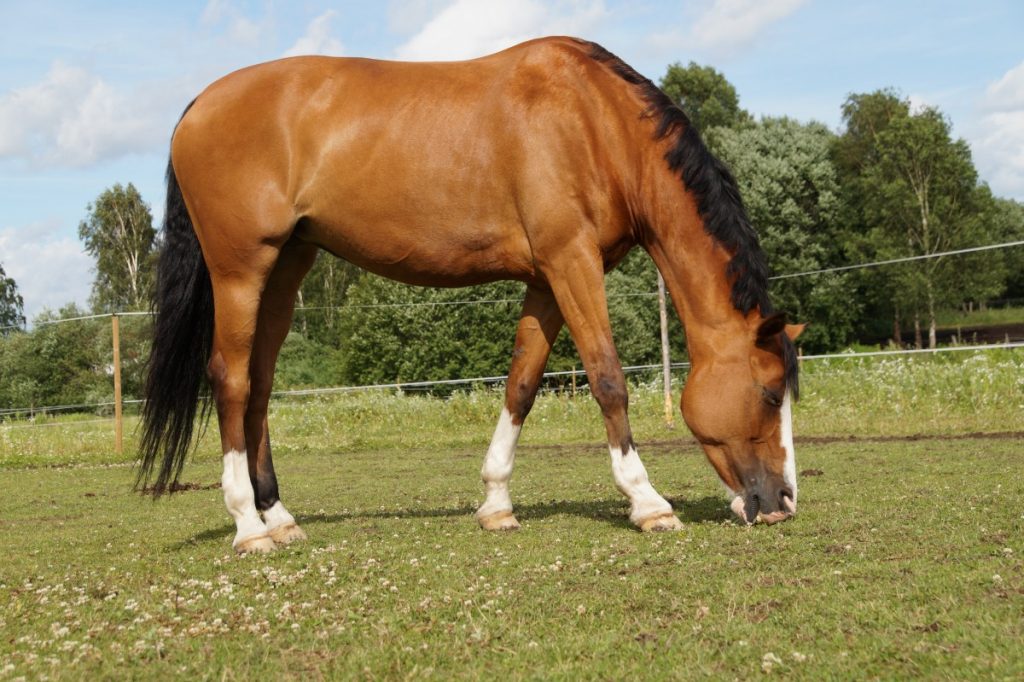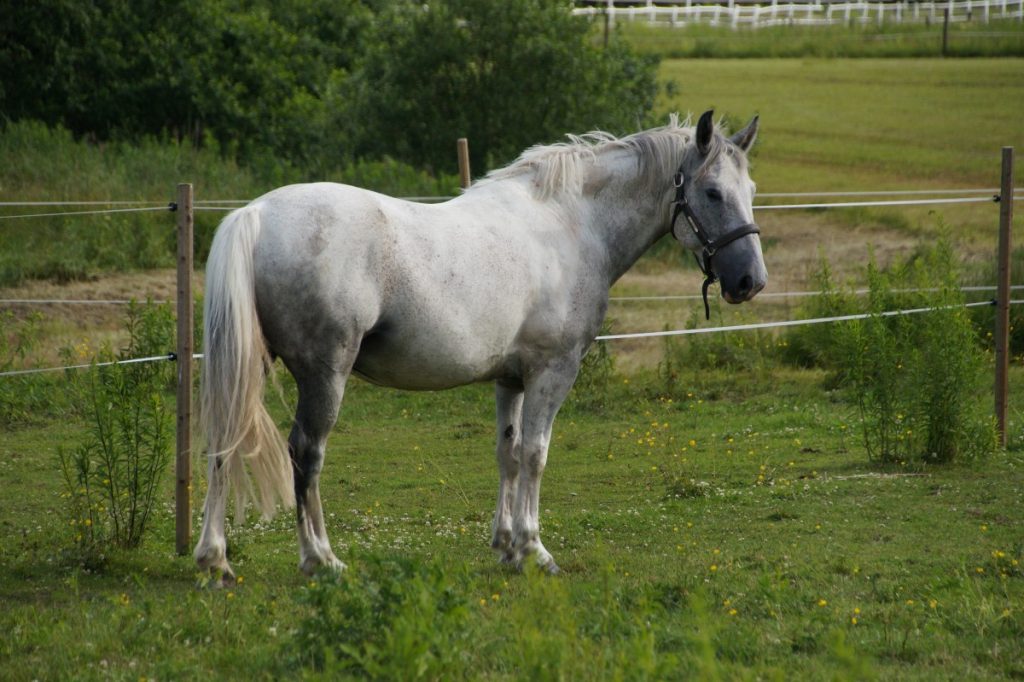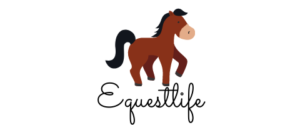If a horse has an opportunity to overeat, it is likely to take it. When a horse consumes a large amount of grain, the starch from the feed can cause horse problems, some of which can be dangerous.
What should I do if a horse overeats? If your horse overeats, follow these steps:
- Call your veterinarian.
- Ice your horse’s hooves.
- Figure out what they ate.
- Gather information for your vet.
Keep on reading to learn what to do if your horse gets into a whole bag of feed and the potential consequences of overeating. You will also learn what makes a horse’s digestive system unique, as well as proper nutritional requirements for a healthy horse.
Steps to Take If Your Horse Ate Too Much
When a horse overeats, they can develop a myriad of serious issues, predominantly in their digestive tracts. If you find that your horse has overeaten, follow these steps:

Step One: Call Your Veterinarian.
The first step if your horse ate a whole bag of feed is to call the veterinarian. While you wait for the vet, there are a few more things you can do to help your horse. A horse overeating is an emergency and requires help. The horse might be fine, but if you decide to wait and see, it could be too late.
Step Two: Ice Your Horse’s Hooves
The next step is to ice your horse’s feet. When a horse overeats, there is an increased risk of problems with the hooves. There are plenty of ice boots on the market to cool off hooves, like this Horseware Ice-Vibe hoof wrap.
Step Three: Figure Out What They Ate.
After calling a vet and taking preventative steps by icing the hooves, try to determine how much food your horse consumed. Also, it is essential to figure out which foods were consumed, and how much was consumed, if at all possible.
Step Four: Gather Information for Your Vet.
For step four, take a good look at your horse and be prepared to gather some helpful information that makes it easier for your veterinarian to help your horse. The following information should be gathered:
- Look for evidence of recent fecal matter from your horse. Your vet will want to know the condition of the stool, if at all possible. If possible, note if your horse has diarrhea and how much manure the horse has passed.
- Pay attention to the intestinal sounds happening as your horse is digesting the food. The colon is broken down into quadrants, and each area overlies a different part of the digestive system of your horse. Ideally, you already know how and where to hold a stethoscope to listen. If you do not, just ask your vet to show you before you need to know.
- Take note of the heart rate and pulse of the horse.
- Get a rectal temperature.
- Look at your horse’s disposition and attitude and note any changes that are not normal.
- See if your horse is dehydrated. You can check their gums for stickiness. If the gums are sticky, your horse is dehydrated. Also, you can do a pinch test near the shoulder. The longer it takes for the skin to snap back, the more dehydrated they are.
- Look closely at the horse’s feet, and be sure your horse can walk normally.
- Check the digital pulse, and check for heat in the feet. Here is a helpful video on how to check the digital pulse and heat in the feet.
What the Veterinarian Is Looking For
When your vet arrives, they will take into consideration everything you observed about your horse and help to ensure a positive outcome. The vet is looking for specific conditions that harm your horse, such as the following:
Laminitis
Laminitis happens when the tissues that connect the bone to the hoof wall experiences a compromised blood flow or becomes inflamed. This condition could be mild or severe. When a horse has a large meal of grain, the grain is not properly digested. A large amount of sugar in the hindgut is the basis for the problem of laminitis.
When the bacteria of the hindgut react to the increase of sugar, lactic acid develops and lowers the pH balance. When the bacteria is not healthy, it irritates the hindgut and kills off some bacteria. The dead bacteria releases toxins that get into the bloodstream and can cause laminitis.
Colic
Colic is a broad term that covers abdominal pain for a horse. Colic cannot be ignored because it can threaten the life of a horse. There are a few different types of colic, but one of the causes of colic is directly related to the diet of the horse. Since grain is full of sugar and starch, it can cause colic because of how the small intestines react to the grain.
Enteritis
Enteritis is the inflammation of the part of the small intestine that is closest to the stomach. The grain is believed to cause the small intestine to swell or distend. This area, when inflamed, is not able to move food through the rest of the small intestine. Also, the inflamed small intestine does not absorb fluid as it should, and this causes dehydration.
Endotoxemia
As the hindgut reacts to the sugar and kills of health bacteria, the dead bacteria create a toxin. This toxin can cause sepsis, which can make a horse very sick. This process is called endotoxemia and can end the life of a horse very quickly.
What Happens If a Horse Overeats Sweet Food?

According to an article from the Penn State Extension titled “Feeding Horses,” understanding the gastrointestinal tract of a horse is essential to understanding how to feed a horse and what happens when a horse is over-fed.
It takes up to three days for a horse to digest food completely. The foregut is the stomach and the small intestine, while everything else is the hindgut.
- Starch, fat, protein, and vitamins absorb in the foregut. This area uses enzymes that come naturally in this area of the system.
- The hindgut, on the other hand, does not have enzymes. This area uses microbes to digest. These microbes are made of bacteria that digest the fiber in the horse’s diet. Therefore, a horse needs a lot of roughage in their diet.
If your horse overeats sweet food, the digestive system becomes out of sync, which may lead to medical problems.
What Is the Proper Diet for a Horse?
The diet of your horse should include a lot of roughage for the fiber content, plenty of water, and just a small amount of grains. A horse should eat approximately 2% of their body weight each day. However, their stomach is small, so feeding them twice a day or more is ideal for preventing overeating at one time during the day.
In Conclusion
Mistakes can happen that lead to a horse getting into a feed bag and enjoying way too much sweet grains. Sometimes this can happen, and there are no negative consequences. Other times, the results are deadly for the horse.
If your horse gets into a bag of grains, you should not merely wait and see if anything happens. It is best to be proactive. The first step to take is to call a vet and get ice on the horse’s hooves. While you wait for the vet to arrive, you can gather some information that will help the vet determine the best course of action. This information includes vital signs and other observations about your horse’s behavior.
